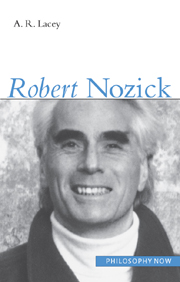Book contents
- Frontmatter
- Contents
- Preface
- 1 Introduction
- 2 Anarchy, State, and Utopia: the moral basis
- 3 Anarchy, State, and Utopia: the political outcome
- 4 The later ethics and politics
- 5 Epistemology
- 6 Rationality
- 7 Metaphysics I: personal identity
- 8 Metaphysics II: explaining existence
- 9 Metaphysics III: free will and retribution
- 10 The meaning of life
- Guide to further reading
- Bibliography
- Index
7 - Metaphysics I: personal identity
- Frontmatter
- Contents
- Preface
- 1 Introduction
- 2 Anarchy, State, and Utopia: the moral basis
- 3 Anarchy, State, and Utopia: the political outcome
- 4 The later ethics and politics
- 5 Epistemology
- 6 Rationality
- 7 Metaphysics I: personal identity
- 8 Metaphysics II: explaining existence
- 9 Metaphysics III: free will and retribution
- 10 The meaning of life
- Guide to further reading
- Bibliography
- Index
Summary
Introduction: identity in general
Personal identity is only one problem among many in the general area of identity, but it is a particularly important and sometimes psychologically pressing one, and Nozick devotes most, but not all, of the first chapter of Philosophical Explanations to it. But let us begin, as he himself in effect does, by looking at identity in general.
When is one thing identical with another? This question sounds absurd, for surely something can be identical only with itself – yet that sounds trivial, if not senseless. Perhaps we should ask instead when what looks like one thing is identical with what looks like another, as in the famous case of the evening star and the morning star. As this example suggests, many (but not all) problems about identity involve time: when is something at one time identical with something at another?
We might try saying: when they have all their properties in common. But how about identical twins? Leibniz thought that strictly speaking such cases were impossible, and had fun mocking a gentleman who searched frantically round the garden for two identical leaves. Nowadays the gentleman might be better advised to look for ball-bearings, or molecules, although even two molecules will be in different places. Perhaps then we should insist that “all their properties” should include spatial and temporal properties, for surely two things cannot occupy the same place at the same time. Actually this has been disputed.
- Type
- Chapter
- Information
- Robert Nozick , pp. 160 - 176Publisher: Acumen PublishingPrint publication year: 2001



